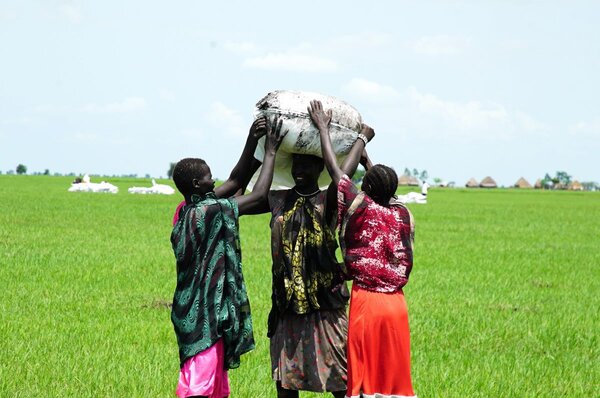WFP airdrops food to prevent catastrophe as hunger surges in conflict-hit parts of South Sudan
These distributions mark WFP’s first access in over four
months to deliver life-saving food and nutrition
assistance to more than 40,000 people facing
catastrophic hunger in the most remote parts of Nasir
and Ulang counties, areas only accessible by air.
“The
link between conflict and hunger is tragically clear in
South Sudan and we’ve seen this over the past few months
in Upper Nile,” said Mary-Ellen McGroarty, WFP Country
Director in South Sudan. “Without a major scale-up in
assistance, the counties of Nasir and Ulang risk
slipping into full-blown famine. We urgently need to get
food to these families, and we are doing everything
possible to reach those who need it most before the
situation spirals.”
More than one million
people across Upper Nile are facing acute hunger,
including over 32,000 people already experiencing
Catastrophic levels of hunger (IPC5) - the highest level
of food insecurity. This figure has tripled since armed
conflict flared in March, triggering mass displacement,
including across the border into Ethiopia where WFP is
providing life-saving food aid to around 50,000 people
who have fled from Upper Nile in search of food and
safety.
WFP aims to reach 470,000 people in
Upper Nile and Northern Jonglei through the lean season
– the hungriest time of year, which runs through August
- but continued fighting and logistical constraints have
hindered access and a comprehensive response. WFP has
only been able to reach 300,000 people in Upper Nile so
far this year.
The main river routes
into the state must be reopened urgently in order to
reach hungry families with sustained humanitarian
support. These routes are the most cost-effective way to
reach large swathes of Upper Nile and northern Jonglei
states to deliver crucial assistance but have been
blocked by active fighting since mid-April. WFP has
1,500MT of food ready to transport once river routes are
operational again.
“Where we have been able
to consistently deliver, we’ve seen real progress,”
McGroarty said. “In the first half of this year, we
pushed back catastrophic hunger in areas of Jonglei
State through regular deliveries of food assistance, and
we can do the same in Upper Nile. But if we can’t get
the food to people, hunger will deepen and famine is a
real and present threat.”
A global funding
slowdown is worsening the already dire humanitarian
situation in South Sudan. Nationwide, 7.7 million people
– 57 percent of the population – are facing crisis,
emergency, or catastrophic levels of hunger. An
unprecedented 2.3 million children are at risk of
malnutrition.
Due to funding gaps, WFP has
prioritized assistance with reduced rations for only the
most vulnerable 2.5 million people—just 30 percent of
those in acute need – to stretch limited resources. WFP
urgently needs US$274 million to continue life-saving
operations through December.
WFP South Sudan emergency page here.
Broadcast quality footage is available
here.
# # #
The United Nations World Food Programme is the
world’s largest humanitarian organization saving lives
in emergencies and using food assistance to build a
pathway to peace, stability and prosperity for people
recovering from conflict, disasters and the impact of
climate change.
Follow us on X, formerly Twitter, via @wfp_media @wfp_SouthSudan




